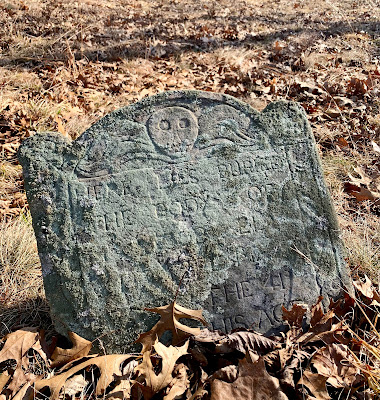Walnut Cemetery is located in one of the more rural areas of Haverhill. I couldn't find what year the cemetery was started, but it's quite old, with a few gravestones dating back to the 1700s. It's still active today, with newer burials and monuments being added. The newer section is well-maintained, but the older section is a little rough looking. It looks, in fact, like a haunted cemetery. There are a lot of tall weeds. Tree branches have fallen on the graves. Some of the oldest monuments are covered in lichen. We went in the winter, so it may just have been between scheduled maintenance. The older section of the cemetery is also on a rocky hill, so perhaps it is harder to cut the grass there. But whatever the reason, the old part of Walnut Cemetery looks a little spooky. I can understand why someone might think it's haunted.
The cemetery is said to be haunted by a ghost known as the Woman in White, who roams through it at night. You don't even need to go inside the cemetery to see her - the Woman in White has also been seen by motorists just driving by. Some people say she's terrifying, but others say she is simply eerie and mysterious. As with so many things, I think your mindset might influence what you see. If you go expecting something scary, that's what you'll probably encounter.
When we visited, I noticed that Walnut Cemetery is located within a triangular crossroads. There's a lot of interesting folklore associated with crossroads, so perhaps it's not surprising there are legends associated with this particular cemetery. The ancient Greeks and Romans believed that crossroads were sacred to Hecate, the goddess of witches, and to Hermes, the divine messenger who guided the dead to the underworld. In England, Scotland and Ireland, people who died by suicide were buried at crossroads, often with stake in their heart. Something similar happened more locally in 1680 in Hampton, New Hampshire, when the citizens of that town buried accused witch Eunice Cole at a crossroads with a stake in her heart. For good measure, they placed a horseshoe on her chest to keep her in her unhallowed grave. And in the American south, legends say that if you want to sell your soul to the Devil, you can find him at a crossroads at midnight.
Speaking of triangular shapes, paranormal investigator Fiona Broome thinks Walnut Cemetery could be linked to a ley line triangle connecting several weird, legendary places in New England. Ley lines are straight lines that connect important locations on a map, and some people believe these lines conduct mystical energy across the landscape. I can't say if that's true or not, but it's another interesting idea to consider when thinking about Walnut Cemetery. Ghosts plus a crossroads plus ley lines must all add up to something, right? Well, it may not, but it's still fun to think about.
Broome and several other ghost hunters investigated Walnut Cemetery back in 2009. They perceived several spirits, including a woman in black, an undefined male spirit, and possibly the restless spirit of a small child. They did not encounter the Woman in White, however.
Who exactly is the Woman in White? Some people think she is the ghost of Lydia Ayer, the most famous person buried in the cemetery. Ayer was immortalized by the Haverhill poet John Greenleaf Whittier in his 1868 poem "In School-days." In this autobiographical poem, Whittier recalls an incident from his childhood, when he lost a spelling bee to a girl in his class. The girl was Lydia Ayer. Rather than revel in her victory, Ayer instead felt sorry for Whittier.
'I'm sorry that I spelt the word:
I hate to go above you,
Because,’ - the brown eyes lower fell, -
'Because, you see, I love you! '
Still memory to a gray-haired man
That sweet child-face is showing.
Dear girl! the grasses on her grave
Have forty years been growing!
He lives to learn, in life's hard school,
How few who pass above him
Lament their triumph and his loss,
Like her, - because they love him.
It's a melancholy poem, and justifiably so, because Ayer died in 1827 when she was just fourteen years old. It's clear that her death made a big impact on Whittier. The poem itself also made a big impact. "In School-days" was one of Whittier's most popular poems, and is often still taught to students today.
Death is the great equalizer, but Lydia Ayer is the star attraction for living visitors to Walnut Cemetery. A wooden sign points towards her grave, which is marked with a large, handsome memorial that was put up in 1937 by a local civic organization. But is her spirit the Woman in White?
I'm not sure. Ayer died when she was just a young teenager, and the Woman in White is usually described as a woman, not a young girl. Maybe people only see that the ghost is female, and can't really discern her age, and think she is a full-grown woman. Or maybe Ayer's ghost actually looks older than fourteen. After all, she's over two-hundred years old. Or maybe it's not her ghost at all. And of course, this could all just be a legend. There may not be a ghost at all.
Women in white are a classic form that ghosts appear in, and stories about them can be found all over the world. In a sense, a Woman in White transcends the story of an individual and partakes in a greater, archetypal identity. In his book Daimonic Reality (2003), Patrick Harpur says the following about "white ladies":
"A ghost? Possibly. But it is a distinguishing characteristic of white lady apparitions they are not individually identifiable. They have deeper resonances than the shade of a historical personage. The time and location are suggestive... an hour and place of transition, of in-between. "
He goes on to say:









